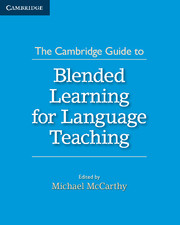Section 2 - Implications for Teaching
Published online by Cambridge University Press: 22 September 2021
Summary
In this section, we consider significant ways in which blended learning impacts upon teaching. Not least of the considerations is the fact that technology-enhanced teaching allows for the complete rethinking of how classrooms operate and how the curriculum can be organised.
Chapter 4, by Johnson and Marsh, begins with an outline of the typical mismatch between the ideal conditions for language learning and the reality of most language learners’ situations. While we know, from SLA studies and the accumulated experience of the language teaching profession, that opportunities for interaction, authentic tasks, adequate time, good feedback, low anxiety levels, and so on are important features of good language learning environments, the reality for many learners is that time and opportunity to use the target language are usually severely restricted. Technology (e.g., the internet) offers wider opportunities for some of the ideal conditions to be enhanced, but the technology alone is not sufficient; it is the quality of decision-making in bringing blended learning into being which is important. The biggest benefit that technology offers is the opportunity to ‘flip’ the classroom. What this means is that work which often consumes time in conventional, faceto- face classrooms can be ‘flipped’ out into the domain of homework. This might include task preparation, reading and vocabulary tasks and the like, which then releases time in the classroom for more genuine interaction. Johnson and Marsh report on a blended learning project which set out to address the problems of restricted time and resources and which implemented the flipped classroom as a response. Central to the chapter is the qualitative study of the impact upon the teachers involved and how they saw their roles in the new setting. Teachers felt the flipped classroom helped their students to be better prepared and enabled more student interaction and less teacher talk in the classroom.
In Chapter 5, the most immediately telling remark by Comas-Quinn is her final sentence: ‘Research need no longer be something that researchers do on teachers, but an activity that is an integral part of the professional development choices available to teachers.’
Information
- Type
- Chapter
- Information
- Publisher: Cambridge University PressPrint publication year: 2015
